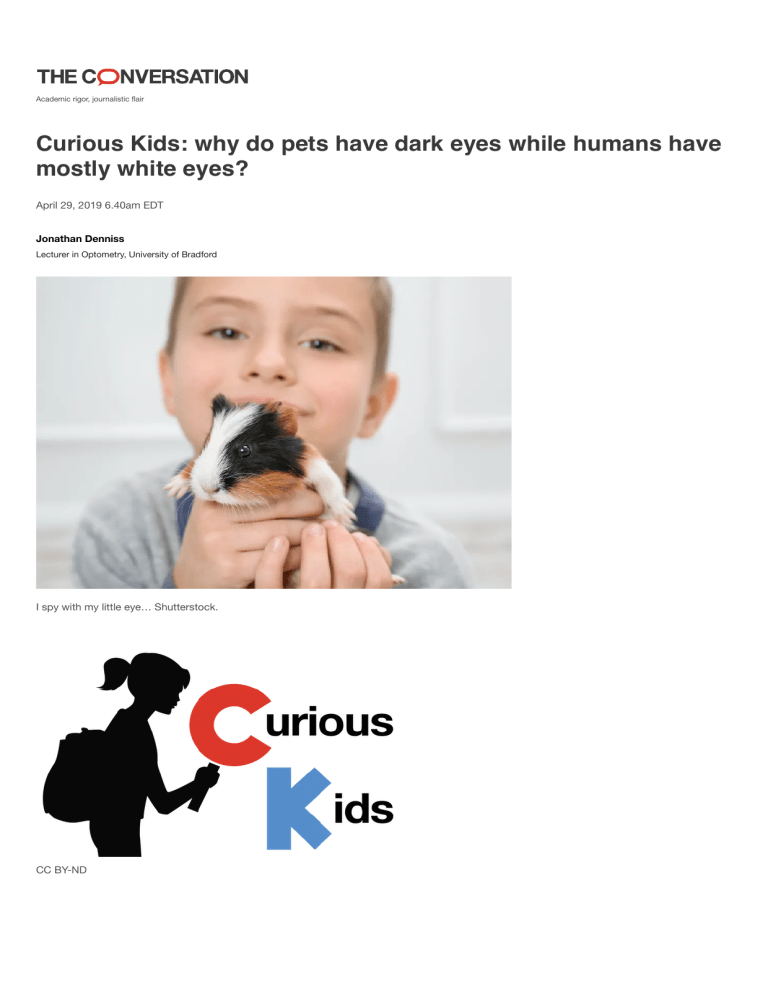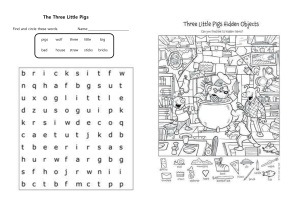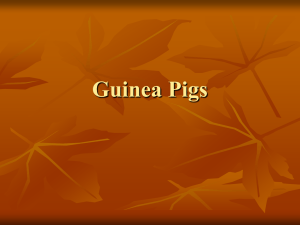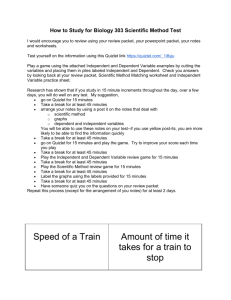
Academic rigor, journalistic flair Curious Kids: why do pets have dark eyes while humans have mostly white eyes? April 29, 2019 6.40am EDT Jonathan Denniss Lecturer in Optometry, University of Bradford I spy with my little eye… Shutterstock. CC BY-ND Curious Kids is a series by The Conversation, which gives children of all ages the chance to have their questions about the world answered by experts. All questions are welcome: you or an adult can send them – along with your name, age and town or city where you live – to curiouskids@theconversation.com. We won’t be able to answer every question, but we’ll do our best. Our guinea pigs have dark eyes. Why do we have white eyes? - Rhoswen, aged three, Bristol, UK. Thanks for the question, Rhoswen. The truth is, guinea pigs also have a white part in their eye, just like humans. But guinea pigs lead very different lives to us, so they need different eyes to help them survive. The white part of our eyes is called the “sclera”. It’s a hard covering which helps keep the eye in a round shape. The sclera goes right around to the back of our eyeballs. But we can’t see all of it, because it’s hidden inside the eye socket – the bony cup in our skull where our eyeballs, and the muscles that make them move, sit. Guinea pigs’ eyes also have a white sclera like ours, but almost all of it is hidden inside the eye socket. So, the coloured part of their eyes is all we can see – it’s usually dark brown, but sometimes it’s blue or even red. Eyes to survive The world is full of weird and wonderful eyes, and each type has special features to help animals survive in their natural habitat. These features have developed over millions of years, passed down from parents to babies, through a process called evolution. Your guinea pigs’ ancestors would have lived in grassy areas, eating plants and trying to avoid being caught by predators. They would have been out and about mainly in the low light of the early morning and evening. Guinea pigs go wild. Brenda Le/Flickr., CC BY-NC You’ll have seen that guinea pigs have a large black hole in the centre of the coloured part of their eyes. This is called the pupil. The pupil is what lets light into the eye. Having a large pupil would have helped the guinea pigs’ ancestors to see a wide area in the dim light – and this would have helped them escape predators, and live long enough to have babies with large pupils, too. Eyes on the sides Guinea pigs’ eyes are also on the sides of their heads, rather than at the front like ours. This allows them to see in almost every direction without moving their heads - very useful for spotting a predator sneaking up from behind. The downside is that guinea pigs’ eyesight isn’t as clear as ours, and their 3D vision isn’t very good. That’s because smaller pupils, like ours, help with seeing things clearly, and 3D vision works better when both eyes are looking at the same object – which is difficult when they’re on different sides of the head. Our human ancestors had to be good at hunting to survive. And having good, clear, 3D vision is very helpful when you’re trying to catch prey for your dinner. That’s why humans today still have eyes with small pupils, at the front of our heads. Some theories also say that humans have evolved visible, white sclera because we’re very social animals, and this can help us to see where other people are looking – or even how they’re feeling – without words. Many animals have eyes even more different to our own. For example, insects’ eyes are made up of thousands of tiny “mini eyes” joined together. Some animals, like crabs, have eyes on stalks. Spiders have different pairs of eyes that they use for different tasks, and some molluscs can have up to 100 eyes. Check out the dragonfly, chameleon, giant squid or mantis shrimp for some more amazing eyes from the animal kingdom. More Curious Kids articles, written by academic experts: What is a meteorite made of and where do they come from? – the children of Year Five at Leigh St. Mary’s Church of England Primary School, Lancashire, UK. Why do tigers have whiskers? – Valentina, aged four, London, UK. How did the months get their names? - Sylvie, aged eight, Brisbane, Australia.




